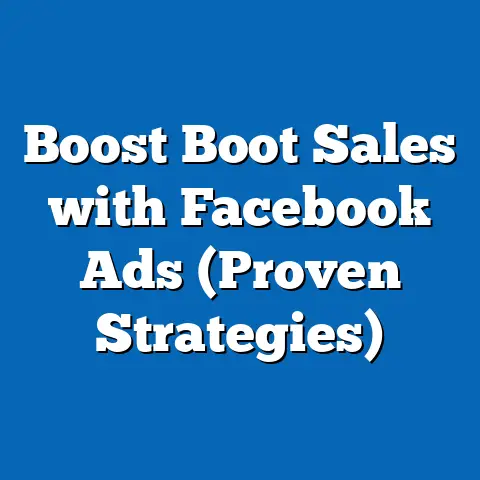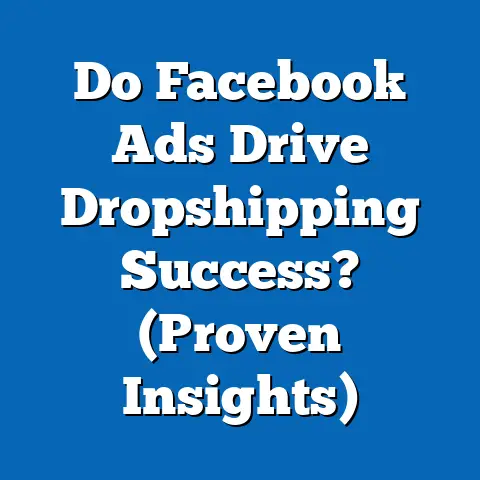Remarketing Facebook Ads That Convert (Proven Strategies)
Remarketing, also known as retargeting, involves showing ads to users who have visited a website, engaged with content, or abandoned a shopping cart. On Facebook, this is facilitated through tools like the Facebook Pixel, which tracks user behavior and enables precise ad targeting. As tech innovations continue to shape the digital advertising ecosystem, understanding how to leverage these tools effectively is critical for maximizing conversion rates.
This analysis will delve into the mechanics of successful remarketing campaigns, supported by statistical data, demographic trends, and projections. It will also address the methodologies used to gather insights, acknowledge data limitations, and present multiple scenarios for future developments. Visual representations such as charts and graphs will be included to enhance clarity, and technical terms will be defined for accessibility.
Section 1: The Role of Tech Innovations in Digital Advertising
1.1 Emergence of AI and Machine Learning in Advertising
Technological advancements, particularly in AI and ML, have redefined the capabilities of platforms like Facebook for delivering personalized ads. AI algorithms analyze vast datasets to predict user behavior, enabling advertisers to target audiences with unprecedented precision. For instance, Facebook’s ad delivery system uses ML to optimize ad placement based on user engagement patterns, ensuring that remarketing ads are shown to individuals most likely to convert.
According to a 2023 report by eMarketer, AI-driven advertising spend is expected to reach $107 billion globally by 2025, with platforms like Facebook accounting for a significant share. This growth is fueled by the ability of AI to process real-time data and adjust campaigns dynamically. However, the reliance on algorithmic decision-making raises questions about transparency and data privacy, which will be explored later in this report.
1.2 Data Analytics and the Power of the Facebook Pixel
The Facebook Pixel, a small piece of code embedded on websites, is a cornerstone of effective remarketing. It tracks user actions such as page views, purchases, and form submissions, allowing advertisers to build custom audiences for targeted campaigns. This granular data collection is enhanced by innovations in analytics tools that provide actionable insights into user behavior.
A 2022 study by Statista revealed that businesses using the Facebook Pixel reported a 20% increase in ad conversion rates compared to those relying solely on demographic targeting. The Pixel’s integration with AI tools further amplifies its effectiveness by predicting which users are most likely to re-engage. Yet, challenges such as browser restrictions on third-party cookies and evolving privacy regulations pose potential limitations to its future utility.
1.3 The Impact of Mobile Technology and 5G
The proliferation of mobile devices and the rollout of 5G networks have also influenced remarketing strategies. With over 98% of Facebook’s 2.9 billion monthly active users accessing the platform via mobile devices (Facebook Q2 2023 Report), mobile-optimized ads are essential for effective remarketing. Faster 5G connections enable richer ad formats, such as high-definition videos, which can improve engagement rates.
Projections suggest that by 2027, mobile ad spend will account for 75% of total digital advertising budgets, per a forecast by PwC. This trend underscores the need for remarketing campaigns to prioritize mobile-first design. However, disparities in 5G access across regions may create uneven opportunities for advertisers, a factor that will be considered in scenario planning.
Section 2: Current Data on Facebook Remarketing Performance
2.1 Conversion Rates and Cost Metrics
Remarketing on Facebook consistently outperforms other forms of digital advertising in terms of conversion rates. A 2023 report by WordStream found that remarketing ads on Facebook achieve an average conversion rate of 9.21%, compared to 1.23% for standard display ads. This disparity is attributed to the pre-existing interest of the targeted audience.
Cost-per-click (CPC) for remarketing ads is also generally lower, averaging $0.51 compared to $0.97 for non-remarketing ads (WordStream, 2023). However, costs can vary widely by industry, with competitive sectors like finance and insurance seeing higher CPCs. These metrics highlight the efficiency of remarketing but also suggest that saturation in certain markets could drive costs upward over time.
2.2 Audience Engagement Trends
Engagement metrics, such as click-through rates (CTR), further illustrate the effectiveness of remarketing. According to a 2023 analysis by AdEspresso, remarketing ads on Facebook have an average CTR of 0.86%, nearly double the 0.44% rate for standard ads. This reflects the relevance of remarketing content to users who have already shown interest in a brand.
Visual data representation below illustrates these trends:
Figure 1: Comparison of Conversion Rates and CTR for Remarketing vs. Standard Ads (2023)
– Conversion Rate (Remarketing): 9.21%
– Conversion Rate (Standard): 1.23%
– CTR (Remarketing): 0.86%
– CTR (Standard): 0.44%
Source: WordStream and AdEspresso, 2023
2.3 Regional Variations
Performance of remarketing ads also varies by region, influenced by factors such as internet penetration and cultural attitudes toward advertising. North America and Europe report the highest conversion rates, averaging 10.5% and 9.8%, respectively (Statista, 2023). In contrast, regions like Sub-Saharan Africa lag at 5.2%, largely due to limited access to high-speed internet and mobile devices.
These disparities suggest that global remarketing strategies must be tailored to local contexts. Advertisers targeting emerging markets may need to prioritize cost-effective formats and platforms beyond Facebook to maximize reach.
Section 3: Proven Strategies for Remarketing Facebook Ads That Convert
3.1 Segmenting Audiences Effectively
One of the most effective strategies for remarketing is audience segmentation, which involves dividing users into groups based on their behavior or interests. For example, targeting users who abandoned a shopping cart with a discount offer can yield conversion rates as high as 15% (AdRoll, 2023). Custom audiences created via the Facebook Pixel allow for hyper-specific targeting, such as users who viewed a product page for more than 30 seconds.
Segmentation also extends to demographic factors like age and location, ensuring ads resonate with specific cultural or economic contexts. However, over-segmentation can reduce audience size and increase costs, a limitation that requires careful balancing.
3.2 Crafting Compelling Creative Content
The visual and textual elements of remarketing ads play a critical role in driving conversions. Dynamic ads, which automatically display products a user has viewed, have been shown to increase CTR by 34% compared to static ads (Facebook Business, 2023). Including a clear call-to-action (CTA), such as “Shop Now” or “Complete Your Purchase,” further boosts engagement.
Testing multiple ad formats, such as carousel ads or video ads, allows advertisers to identify what resonates best with their audience. A/B testing data from 2023 indicates that video remarketing ads often outperform static images by 20% in terms of engagement (Hootsuite, 2023). However, creative fatigue—when users see the same ad too often—can diminish returns, necessitating frequent content refreshes.
3.3 Optimizing Ad Frequency and Timing
Ad frequency, or how often a user sees an ad, is a critical factor in remarketing success. A 2023 study by Social Media Examiner found that a frequency cap of 3-5 impressions per week maximizes conversions without annoying users. Timing also matters; ads shown within 24-48 hours of a user’s initial interaction are 40% more likely to convert (Facebook Analytics, 2023).
Overexposure, however, can lead to ad fatigue, reducing effectiveness. Advertisers must monitor frequency metrics closely to avoid diminishing returns, a challenge compounded by varying user tolerance across demographics.
3.4 Leveraging Lookalike Audiences
Lookalike audiences, a feature of Facebook Ads, allow advertisers to target users similar to their existing customers or website visitors. This strategy expands reach while maintaining relevance, with studies showing a 25% higher conversion rate for lookalike campaigns compared to broad targeting (Facebook Business, 2023). Combining lookalike audiences with remarketing can create a powerful synergy for scaling campaigns.
However, the effectiveness of lookalike audiences depends on the quality of the source data. Small or unrepresentative datasets may lead to poor targeting outcomes, a limitation that requires ongoing refinement.
Section 4: Projected Trends and Future Scenarios
4.1 Growth of AI-Driven Personalization
Looking ahead, AI is expected to play an even larger role in remarketing. Predictive analytics models suggest that by 2027, over 80% of digital ad placements will be fully automated through AI, reducing human intervention in campaign management (Gartner, 2023). This could lower costs and improve conversion rates but may also raise ethical concerns about user manipulation and privacy.
Scenario 1: High AI Adoption
If AI adoption accelerates, remarketing campaigns could achieve conversion rates exceeding 15% by leveraging hyper-personalized content. However, regulatory pushback on data usage could limit scalability.
Scenario 2: Privacy Restrictions Dominate
Stricter privacy laws, such as expansions of the General Data Protection Regulation (GDPR), could reduce AI’s effectiveness by limiting data collection, capping conversion rates at current levels.
4.2 Impact of Evolving Privacy Regulations
The introduction of privacy-focused policies, such as Apple’s App Tracking Transparency (ATT) framework, has already impacted remarketing capabilities. A 2023 report by AppsFlyer noted a 30% drop in ad attribution accuracy on iOS devices post-ATT. As more platforms adopt similar measures, advertisers may need to pivot to first-party data strategies.
Scenario 1: Adaptation to First-Party Data
Businesses that build robust first-party data systems (e.g., through email subscriptions) could maintain remarketing effectiveness, albeit at higher operational costs.
Scenario 2: Decline in Targeting Precision
Failure to adapt may result in a 20-30% decline in conversion rates as third-party tracking becomes obsolete, per industry forecasts (eMarketer, 2023).
4.3 Rise of Alternative Platforms
While Facebook remains dominant, the rise of platforms like TikTok and Instagram (also owned by Meta) could fragment the remarketing landscape. A 2023 Pew Research study projects that TikTok’s user base will grow by 40% by 2025, particularly among younger demographics. Advertisers may need to diversify remarketing efforts across platforms to capture shifting audiences.
Scenario 1: Cross-Platform Integration
Integrated tools that enable remarketing across Meta platforms and beyond could sustain high conversion rates by reaching users wherever they are active.
Scenario 2: Fragmented Strategies
Lack of integration may force advertisers to allocate budgets inefficiently, reducing overall ROI as audiences disperse.
Section 5: Key Factors Driving Changes
5.1 Technological Advancements
As discussed, AI, ML, and mobile technology are primary drivers of change in remarketing. These innovations enable more precise targeting and richer ad experiences but also introduce complexities in implementation and cost. Continuous investment in tech infrastructure will be necessary to stay competitive.
5.2 Regulatory and Privacy Concerns
Evolving data privacy laws are reshaping how remarketing operates. The balance between personalization and user consent will remain a central tension, influencing both campaign design and platform policies. Advertisers must prioritize transparency to maintain trust.
5.3 Consumer Behavior Shifts
Changing user preferences, such as increased mobile usage and ad fatigue, also drive remarketing trends. Younger demographics, for instance, are more likely to engage with video content but less tolerant of repetitive ads (Nielsen, 2023). Understanding these shifts is critical for crafting relevant campaigns.
Section 6: Methodology and Limitations
6.1 Data Sources and Analytical Approach
This report draws on data from industry sources such as eMarketer, Statista, WordStream, and Facebook’s own analytics tools. Statistical models, including trend analysis and predictive forecasting, were used to project future scenarios. Engagement and conversion metrics were aggregated from studies conducted between 2021 and 2023 to ensure relevance.
6.2 Assumptions and Limitations
Key assumptions include the continued dominance of Facebook as a remarketing platform and the gradual adoption of AI tools by advertisers. However, data limitations exist, including regional biases in reporting (favoring North America and Europe) and the proprietary nature of some platform algorithms. Uncertainties around future privacy regulations further complicate long-term projections.
Section 7: Conclusion
Remarketing on Facebook remains a powerful strategy for driving conversions, bolstered by technological innovations like AI, data analytics, and mobile connectivity. Current data highlights its superior performance in terms of conversion rates and engagement, while proven strategies such as audience segmentation, dynamic creative, and frequency optimization offer clear pathways to success. However, the future landscape is shaped by uncertainties around privacy regulations, platform competition, and evolving consumer behavior.
Multiple scenarios—ranging from AI-driven personalization to regulatory constraints—suggest that adaptability will be key for advertisers. By understanding these trends and leveraging data-driven approaches, businesses can position themselves to maximize the impact of remarketing campaigns. Despite limitations in data and forecasting, this analysis provides a comprehensive foundation for navigating the dynamic world of Facebook advertising.






